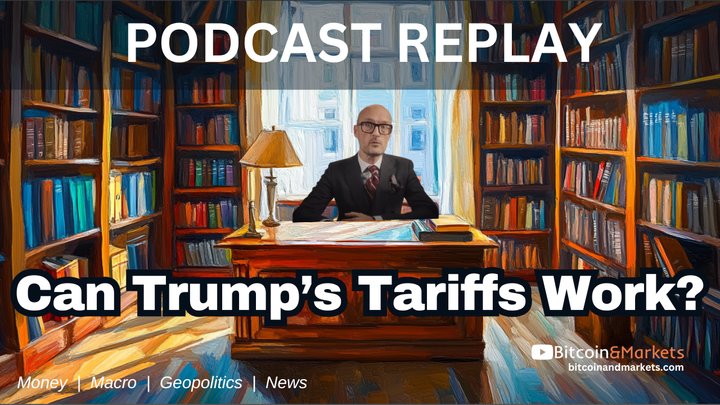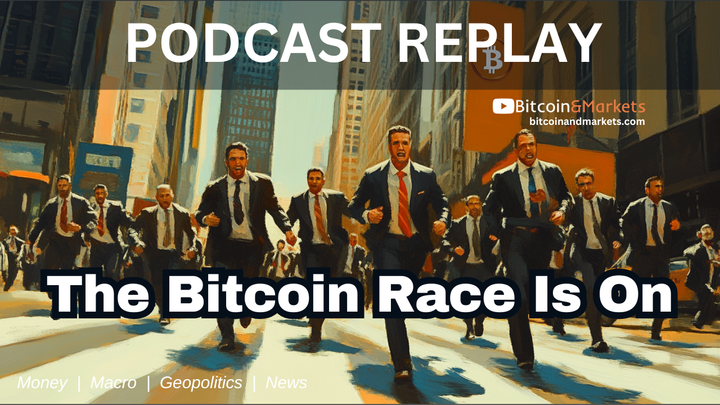The Case for Deflation: Part 1 - E211
I describe two important schools of thought on the global monetary system and the future of the dollar: the Dollar Milkshake and the Eurodollar.

In part one of this series I describe two important schools of thought on the global monetary system and the future of the dollar: the Dollar Milkshake and the Eurodollar. Then I try to establish a definition for inflation as a monetary phenomenon based on mainstream Milton Friedman, Mises and my own defintition. Lastly, I ask the question if what we think of as monetary expansion today, is actually monetary expansion.
In part two, I’ll discuss the differences I see between debt based money, fiat and commodity money.
Get The Bitcoin Dictionary!
Bitcoin jargon demystified. Over 180 Bitcoin terms, concepts, and idioms.
bitcoindictionary.cc
The TOP Free Bitcoin Newsletter!
Don't miss another issue. Subscribe to the Free tier!
Subscribe to the Pod!
iTunes | Stitcher | Google Pods | YouTube | Soundcloud | RSS
The Show Needs Your Support
We’re a small operation and producing quality content people find valuable.
Check out our big list of ways to help the show
Affiliates
- Chart Like A Pro With TRADINGVIEW
- The Best WordPress Theme I’ve Ever Used! GeneratePress
- Sign Up For Audible And Get 2 FREE Audio Books
Have Feedback? Send it our way.
**DISCLAIMER: This is not investment advice, do your own research.**
Transcript
by Bradley Stone
Hello Bitcoiners, welcome back to the show. This is going to be the first in a series of episodes about the strong dollar. I’ve gotten several requests for this, so I’m going to be releasing this first on Patreon and then on discord as well, because people on discord were asking for some clarification. So I’m going to release this first here and a couple days later on the public feed.
I’m going to go over my thesis for a strong dollar. It’s a mix of some other ones out there, so I want to introduce you to some of the different schools of thought.
Brent Johnson of Santiago Capital has been on Realvision a bunch, and he’s the creator of the “dollar milkshake” theory. Brent uses the Highlander as analogy, that “there can be only one” money out there in the world. The dollar is going to go out there cutting heads off, and then it’ll have a final showdown with gold. Bret’s ultimately a gold guy, but he thinks in the meantime there’s going to be a strong dollar that kills all the other fiat currencies around the world.
To see how this works, let’s go back to 2008 during the financial crisis, and even before that and for at least 50 years, the dollar was the main export of the United States and it became entrenched everywhere. Global finance consolidated onto the dollar.
If you look at what currency most loans are created with globally, the dollar stands at 75-80% Then consider what kind of money is held in reserves around the world, and it’s 60% US dollar. There’s an enormous amount of business done in the dollar. Also, the pricing of commodities, and not just oil but a multitude of commodities, are heavily priced in dollars. The US is the biggest import market in the world, and we export dollars with all these imports.
And everybody needed dollars to buy oil and other commodities, so over time it became entrenched. During the financial crisis, the US embarked on a huge money-printing campaign, increasing the base money at the Fed by four times, or 400%.
Everybody around the world thought this was going to mean a drastic inflation in the dollar, so they levered-up. All of this put together makes a huge demand for the dollar, then when the dollar goes up, it’s a short squeeze. It squeezes all of the emerging markets, it squeezes anybody with debt around the world, and everyone flies back into the dollar.
When you have defaults, you have a contraction of the money supply. Over the last four years, we’ve been raising rates while the US changed from an inflationary force to sucking all the capital out of the “world milkshake”. Everyone was printing at the same time, mixing up this big currency milkshake. Then the Fed stopped printing, and the dollar drank all the capital from around the world.
The US enjoyed some of the only positive interest rates in the developed world, and the US stock market outperformed compared to everywhere else. Everybody wanted to be in the dollar and dollar-denominated assets. That’s what Bret means about drinking the milkshake of the world.
Jeff Snider from Alhambra investments who’s spoken on the Eurodollar University has similar ideas. He concentrates on the fact that the Federal Reserve is not central to the dollar system. I think of it as the European Monetary Union — There is still a central bank of France, but it’s not central to the Euro.
The Fed is the Central Bank of the United States — A domestic bank. So they play a domestic bank’s authority role. And the dollar system is global, it’s much bigger outside of the United States. Dollars can be created outside of the United States: banks get dollar reserves and then have a 0% reserve ratio that they have to keep, and they can pyramid on that infinitely. Whatever deposits in dollars they get, they can pyramid on that infinitely.
He’s saying we don’t understand how this system is working, and the Fed is not in control — the Fed is following. They are just reacting and it’s all an illusion that the Fed has any control at all.
I’m starting to buy into this because I’ve mixed it with my own theories and some other theories around the difference between debt-based money and commodity money. It’s not fiat money — There’s a difference, and we’ll go into that here in a little bit.
Inflation is always and everywhere a monetary phenomenon in the sense that it is and can be produced only by a more rapid increase in the quantity of money than in output. – Milton Friedman
Milton Friedman wasn’t an Austrian, but he was a monetarist from the Chicago School, and he believed that all you need to do is increase the money supply by a steady or fixed amount, then you can control growth through that.
Freidman said inflation is always and everywhere a monetary phenomenon, in the sense that it can be produced only by a rapid increase in the quantity of money over output (by a ratio). We’ve talked about inflation being more money chasing the same amount of goods, but if more money is chasing a greater amount of goods, it’s the ratio involved.
Inflation, as this term was always used everywhere and especially in this country, means increasing the quantity of money and bank notes in circulation and the quantity of bank deposits subject to check. But people today use the term “inflation” to refer to the phenomenon that is an inevitable consequence of inflation, that is the tendency of all prices and wage rates to rise. The result of this deplorable confusion is that there is no term left to signify the cause of this rise in prices and wages. There is no longer any word available to signify the phenomenon that has been, up to now, called inflation. – Mises
In his book Economic Freedom and Interventionism ( I believe this his last book in the 70s, maybe the 80s), on page 123 Mises explains that inflation as a term was always used everywhere and especially in the US to mean “increasing the quantity of money and banknotes in circulation, and the quantity of bank deposits subject to check.” But people today use the term “inflation” to refer to the phenomenon that is an inevitable consequence of inflation.
“The inevitable consequence of inflation”, or the tendency of all prices and wages to rise. The result of this deplorable confusion is that there is no term left to signify the cause of this rise in prices and wages. There is no longer any word available to signify the phenomenon that has been up to now called inflation.
In my new book Bitcoin Dictionary, a primer on Bitcoin that’ll be released here shortly, I define inflation as “expansion in the supply of a good, usually money; monetary expansion. The modern-day meaning of inflation has been redefined to mean an increase in the general price level, which is impossible to accurately measure. Adding to the confusion, mainstream economists have invented many subcategories of inflation measures, like the Consumer Price Index, Producer Price Index, Personal Consumption Expenditures Index, Commodity Price Index, Core Inflation, Wage Inflation, Asset Inflation, etc. Despite all this, it’s still self-evident that the more money chasing the same number of goods must cause some prices to increase.”
I think we all agree that inflation is a monetary phenomenon, but it’s been corrupted to mean price increases.
Time for a leading question, and I think I’ll end this episode here. We went through these different theories and quotes, now the question is, if inflation is monetary expansion – which inevitably increases prices, in the long term, prices go up – and if we aren’t seeing prices increase, do we have monetary expansion? Can monetary expansion ever lead to prices not going up? That was the leading question, because it’s exactly what we are seeing now.
Sure, we have some mild inflation, but in the eight years from 2008, there was a 400% increase in the balance sheet of the Fed. Since then, we haven’t seen inflation near those levels. Yes, we’ve seen some inflation in certain stocks and financial assets, which I’ll get to a little bit later, but what’s the long-term effect? The end of the story will not be inflation, it will be deflation.
We had the financial crisis, they pumped their balance sheet by 400%, and the end result 10 years later is a deflationary collapse.
Why is that?
It inevitably leads to inflation, but if the Federal Reserve did nothing, and the United States government did nothing, prices would drop to zero. We’re seeing this in oil right now, which hit $2 a barrel today. That is incredible. If we do nothing, prices fall. The only way prices stay up is by “printing money”. The near-term effect of printing is inflation and the long-term effect of printing is deflation. I think we need to ask ourselves whether we are considering the wrong thing “money”?
I agree with these definitions of inflation, and I agree that monetary expansion will always lead to higher prices at the end. But what we’re seeing now is the end of this deflation. I don’t think people understand what money is because we don’t see the inflation. That’s why I think the end of the dollar will not be an inflationary collapse. It will be a deflationary seizing of the market, then they’ll have to return to the Bretton Woods system, or a Bretton Woods 2.0.
In the next episode and part of this series, we’re going to talk about the differences between debt-based money, Fiat and commodity money, then I’ll open it up to questions from you. If you guys are listening to this on Patreon or on Discord, ask me a question and I’ll get back to you. That’s all I have for this one, guys. We’ll see you on the next one.




